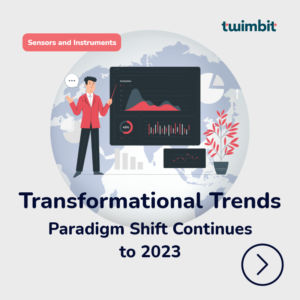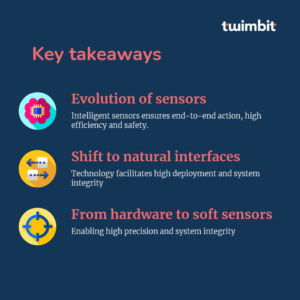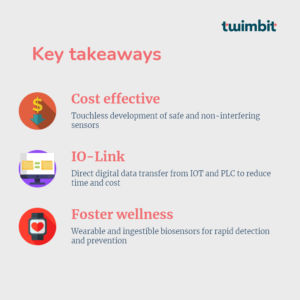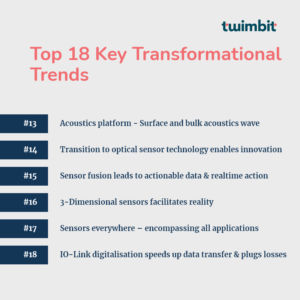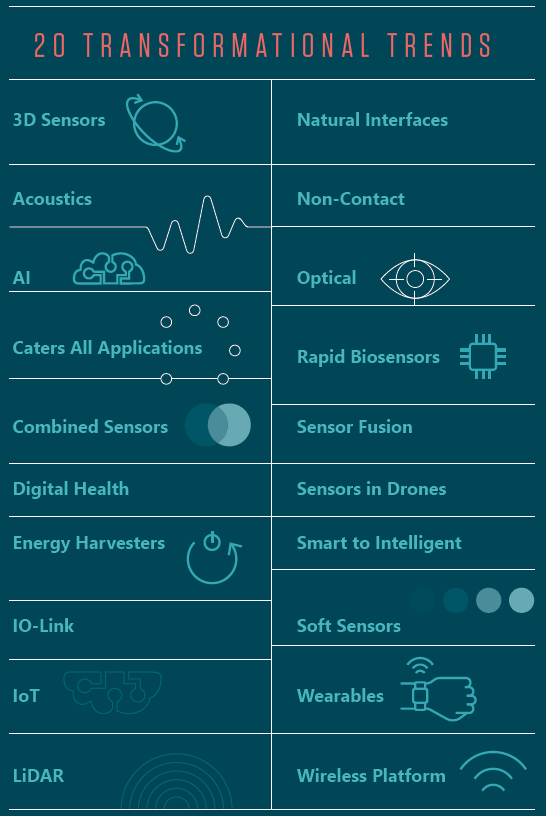Key Takeaways
- Sensors are evolving to be intelligent, thinking, analytical and diagnostic with power to take desired corrective action. Intelligent systems are self-reliant to maintain high end-to-end efficiency and safety.
- Technology development has led to increased deployment of natural sensor interfaces which are highly secure and most dependable.
- Soft sensors are gradually taking over functions from physical sensors to enable high precision in integrated systems.
- Increasing non-contact technology platform is used to develop new sensors as they are safe and do not interfere with the medium. These technologies are also cost effective.
- IO-Link allows direct digital data transfer from IoT and PLC which is very cost effective, fast with zero data loss.
- Rapid detection biosensors address unmet needs for immediate detection of viruses with potential for pandemic.
- Adoption of IoT platform opens up large opportunities for connected devices to reach 21.5B in next 3 years.
- Wearable and ingestible sensors address large preventive health needs.
1. 3-D Sensors Spells Dimensional Accuracy
Technological advances in 3-D depth sensors has facilitated applications such as advanced manufacturing, physical security systems, intelligent cars and transportation systems, interactive gaming, and service robots. 3-D is gaining penetration in industrial production in both process and discrete sectors.
Multiple approaches to acquire 3-D visual data include time-of-flight (TOF), structured light, stereovision, and interference. The impact that 3-D depth and tactile imaging sensors bring about for various applications, ranges from consumer electronics to human-machine interfaces immensely aids advanced designing and decision making. DARPA developed 3-D techniques for military and surveillance which is widely deployed.
Growth Impact: Demand for 3-D sensors is growing due to the need for high precision in designing, operational control and safety.
2. Acoustics – Surface Acoustic Wave and Bulk Acoustic Wave Ensure Safety
Surface acoustic wave (SAW) and bulk acoustic wave (BAW) and have been explored as common platforms for a large number of sensors and biosensors for both industrial, health wellness and consumer applications. Early this year Sensor Kinesis has innovated rapid Ebola detection biosensor based on SAW technology. Significant opportunities exist to explore acoustic technologies for diverse
applications as they are very inexpensive. Also BAW is extensively used in smartphones for speaker applications.
Growth Impact: Potential to detect large number of parameters using acoustics creates demand. Large replacement and expansion market for smartphones and similar portable devices ensure large demand.
3. Adoption of Energy Harvesters Enable Self-Reliance in Powering Sensors
Standalone sensors located in remote locations, wireless sensors, and continuous monitoring sensors need to be self-powered. To enable self-powering of sensors, energy harvesters developed are experiencing increased deployment. These micro-energy harvesting systems generate electrical power from diverse sources such as solar, vibration, and thermal energy.
It is penetrating diverse uses like aerospace, automotive, environmental monitoring, consumer electronics, medical devices, and implantable sensors, homeland security and defense. Lord Microstrain has developed a new method using piezoelectric materials to convert strain energy to stored electrical energy.
Growth Impact: Continuous power supply to stand alone & integrated sensors triggers demand.
4. Artificial Intelligence Creates Thinking Sensors
Technology evolution in machine learning has enabled machines, aided by computers, to think like humans, have trait of speech recognition, translate between languages, and visual perception. Embedded artificial intelligence (AI) empowers machines with real time decision making. Proliferation of sensors with AI is leading the paradigm change towards precision control applications in both process and discrete industrial space. AI is gradually penetrating into commercial and consumer space
Growth Impact: Extensive proliferation for sensors with intelligence enables real-time data analysis and course correction. Also, field device interactivity is more at high levels of precision and integrity.
5. Combined and Hybrid Sensors Facilitate Multi-Parameter Sensing
Combinational sensors are deployed for monitoring more than one parameter. In addition to hard to reach places, they are also used in closed loop automation applications. Sensors like temperature + humidity, pressure + flow, vibration + acceleration + deceleration sensors are the most deployed combined sensors. Technologists are working to develop a greater number of combinations for sensing diverse parameters simultaneously in real time.
Growth Impact: Gradual shift as limited combined sensors are available.
6. Digital Health Platform Ensure Health Wellness
Both preventive and diagnostic health has exhibited increasing reliance on sensors. Sensor applications include life-supporting implants, preventive measures, long-term monitoring of disabled and seriously patients, robotic surgery and remote patient monitoring. The dependence on sensors in both point of care and home diagnostic markets is increasing day after day.
IoT compliant and wearable sensors thrive in health wellness applications. Sensors have facilitated elderly care monitoring. They have proliferated into every medical applications and artificial intelligence, DNA testing, 3D-printed organs and IoT using digital platform is changing the health wellness paradigm.
Growth Impact: High precision, speed, remote patient interface and newer possibilities are strengthening the sensor penetration into health wellness. As per published report CB Insights quote in 2020 “a total of $80.6B in equity funding was raised across 5.5K+ deals. North America, Asia, and Europe all saw a boost in funding year-over-year (YoY). There were 187 healthcare mega-rounds ($100M+) in 2020, a new record”. Sensors continue to benefit to benefit from such investments in healthcare.
7. Future of Connectivity Assured by Wireless Sensor Networks
Distance energy cluster structure algorithms (DECSA) are a drastic improvement over low-energy adaptive clustering hierarchy (LEACH). DECSA considers distance and residual energy information of nodes and increases life and reduces energy consumption in wireless networks.
Growth Impact: Low-energy clustering enhances both efficiency & speed of wireless networks.
8. Intelligence is the New Smart Sensor
The new smart is intelligent. Increasing intelligence is embedded in sensors which are used in diverse applications. These sensors are functionally diagnostic with corrective attributes. Most sensors have migrated from interactive to being prognostic. A large number of sensors are likely to be prognostic
to control mishaps and eliminate course correction requirement. The technology roadmap is anticipated to lead to cognitive attributes in sensors.
Growth Impact: It is a large growth opportunity for all sensors that are embedded with intelligence. They facilitate multiple applications that require high precision control.
9. IO-Link Digitalisation Speeds Up Data Transfer and Beefs Up Integrity
IO-Link enables digital connectivity direct data transfer from sensors onto IoT interface and programmable logic controllers (PLC). IO-Link technology is costs effective compared to analog systems. IO-Link is a short distance, bi-directional, digital, point-to-point, wired or wireless, industrial communications networking. It follows IEC-61131-9, IEC 60947-5-2 standards for connectivity. IO-Link controls communication with the connected IO-Link sensors, devices and systems irrespective of being smart or level of intelligence.
Growth Impact: Most systems are shifting to digital platforms and also IO-Link allows direct data transfer from sensors to IOT and PLC which is likely to boost large scale adoption.
10. IoT Enables Remote Monitoring and Control
Enabled by IOT compatible sensors, a gradual shift to remote monitoring in both industrial and commercial domains is happening. These sensors have empowered supervisors to remotely use IOT platform for critical control functions especially in large process plants like petrochemical and refineries. This real time monitoring and control using IOT platform irrespective to the level of criticality ensures zero down time, complete safety, high process efficiency and integrity.
Growth Impact: Adoption of IOT is on the rise. Most sensors are now compatible with IOT platform. Number of IOT connected device estimated to reach 21.5 billion by 2023.
11. LiDAR Sensors Captures Millions of Data Points Instantly
Recently, LiDAR, a non-contact sensor, has been developed with various wavelengths to meet application needs like automotive, environmental, wind energy, surveying, and aerospace. The product differentiation in LiDAR is application dependent. Reduction in LiDAR product size is a continuous effort by designers and technologists. LiDAR is one of the sensors with ever expanding applications landscape.
Growth Impact: Higher adoption is supported by R&D and product development.
12. Natural User Interface and Sensory Tracking Change Paradigm
High sensitivity in speech, touch, and gestures has enabled their integration as primary interfaces for interacting with computers. Lack of precise device positioning and mapping sensors exists. The ability of devices to detect presence and position enables various novel and new interaction models.
Growth Impact: Shift to natural interfaces ensures security, cost efficiency & precision.
13. Non-Contact Technologies Eliminate Interference
Non-contact technologies like infrared, optical, ultrasonic, magnetic, laser, LIDAR, image, and acoustics are experiencing technology development and increasing deployment. Currently, infrared temperature sensors are experiencing high demand for COVID detection and monitoring. Non-contact technologies are experiencing strong demand from industrial hygienic and health wellness applications.
Growth Impact: Penetration into most process applications due to higher accuracy.
14. Rapid Detection Biosensors Facilitates Instant Diagnosis
Development of rapid detection biosensor devices eliminates sample enrichment prior to detection of diverse pathogens like food, Ebola, COVID and many more. Food pathogens like E. coli has two versions – one can detect up to two pathogens and the other, which is still under trial, can detect up to four
pathogens/analytes. Recently Sensor Kinesis developed a rapid detection biosensor based on surface acoustic technology for detection of Ebola.
For detection of COVID-19, a fast point-of-care test based on isothermal DNA amplification was developed in early part of 2020. CRISPR gene-editing tools benefit from high sensitivity and specificity of molecular diagnostics and easy use of lateral-flow assays. Sample pooling and DNA sequencing accelerate mass testing in emerging rapid detection biosensors.
Growth Impact: Unmet need for rapid detection of pandemic viruses drives this growth.
15. Sensor Fusion Empowers Real-Time Intelligent Decision Making
Intelligent sensors are accelerating development of fully automated and driverless vehicles. Such sensors support low to high level sensor fusion techniques in automotive safety systems. The sensors have embedded intelligence for accurate decision making and real-time action implementation. Fusing data from multiple sensor sources is to take advantage of the strengths of each different sensor. These intelligent sensors enable integration of systems, data analysis, and control in automated cars. Data Fusion techniques are widely used in integrated industrial operating systems to ensure safety and by military for security applications.
Growth Impact: Integrated systems require data fusion from sensors resulting in high intelligence. Shift to integrated systems across all vertical end-users opens large business opportunities.
16. Sensors in Drones Enhance Capability
Drones are identified are flying sensor assemblies. Drones are fully sensor dependent. Sensor types used in drones include, LiDAR, tilt sensor, inertial measurement unit, current sensor, magnetic sensor, anisotropic magnetoresistive (AMR) permalloy technology sensors, accelerometers, engine intake flow sensors, GPS, gyroscopes, position sensors and in some temperature sensors.
Communication control with the connected sensors, devices and systems ensure safety and precision. GoPro, Boeing, Lockheed Martin, 3D Robotics, Parrot SA, Yuneec, Autel Robotics, Hubsen, and AeroVironmen are key drone manufacturers competing in this market. Drones are penetrating into mail delivery, courier, surveillance, mapping, surveying, and light material handling applications. The applications have just begun to expand into multiple vertical markets.
Growth Impact: The drone market is at the introductory stage of its life cycle and opportunities to grow are massive.
17. Sensors Penetrate Every Application
Extensive proliferation of sensors into diverse application across all end-user markets has resulted in increasing demand for sensors across all regions. Sensors find use in every conceivable application. Sensors have become the eyes, ears, advisers and even crisis managers for most automation systems. Development of new sensors for both existing and potential applications, upgradation of existing sensors, and adoption of product differentiation is leading to higher market growth and penetration.
Growth Impact: Increasing reliance on sensors is estimated to result in continuous increasing demand for sensors in next several decades.
18. Shift to Soft Sensors Ensures High Precision in Integrated Systems
Increasing hard sensor applications are shifting to soft sensors. This trend is most prominent in process automation where many control functions are activated by software and aided by computers. It allows ease of customization for process control and discrete functions. Innovation and higher level automation is strengthening this trend. High reliability and precision is the hallmark of soft sensors. Some peculiar applications include water treatment and a pH-based soft-sensor used to detect ammonia peak load events.
Growth Impact: Strongly supported by higher level automation, IOT, intelligence and real time
analytical ability and strong penetration of wireless sensor networks.
19. Transition in Optical Sensor Technology Expand Application Base
Optical technology is ubiquitous. The development of an integrated chip made mostly or completely from silicon, on which the optics and electronics part is likely to be integrated. Optics and photonics technologies (part of optical technology) have attained mass installed base as they are used in smart phone displays, computing devices, use of optical fiber is IoT, medical diagnostics, military enhanced capabilities, and industrial precision manufacturing.
Growth Impact: Opportunities from solar power and exponential growth of internet & IoT.
20. Wearable and Ingestible Sensors Transfer Health Data in Real-Time
Innovations in wearable sensors have brought in paradigm change in health monitoring. They are increasingly playing a vital role in preventive care. Wearable devices provide data on quantified self-movement and various physiological data which enables precise diagnostics. They provide mobility, connectivity, and context awareness with each other and the rest of the world. Host of sensors like image (CMOS), vibration, glucose and optical are used in these vital devices.
Growth Impact: A big push for shift to preventive health monitoring opens large opportunities. All stake holders of healthcare industry like federal govt, state govt, insurance companies, healthcare professionals, fitness experts and device manufacturers are all working towards strengthening preventive care; thereby opening up large opportunities for growth.


